双向链表
双向链表简介
链表有多种不同的类型,本节介绍双向链表。双向链表和普通链表的区别在于,在链表中, 一个节点只有链向下一个节点的链接;而在双向链表中,链接是双向的:一个链向下一个元素, 另一个链向前一个元素
双向链表的缺点:
- 每次在插入或删除某个节点时,都需要处理四个引用,而不是两个,实现起来会困难些;
- 相对于单向链表,所占内存空间更大一些;
- 但是,相对于双向链表的便利性而言,这些缺点微不足道。
双向链表的结构:

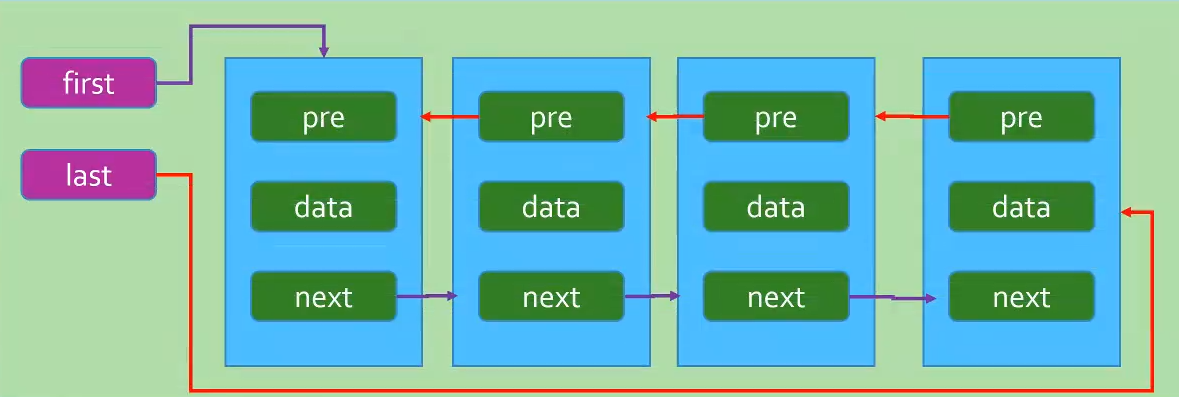
- 双向链表不仅有head指针指向第一个节点,而且有tail指针指向最后一个节点;
- 每一个节点由三部分组成:item储存数据、prev指向前一个节点、next指向后一个节点;
- 双向链表的第一个节点的prev指向null;
- 双向链表的最后一个节点的next指向null;
双向链表常见的操作(方法):
-
append(data):向链表尾部添加一个新的项;
-
inset(position,data):向链表的特定位置插入一个新的项;
-
get(position):获取对应位置的元素;
-
indexOf(data):返回元素在链表中的索引,如果链表中没有元素就返回-1;
-
update(position,data):修改某个位置的元素;
-
removeAt(position):从链表的特定位置移除一项;
-
isEmpty():如果链表中不包含任何元素,返回trun,如果链表长度大于0则返回false;
-
size():返回链表包含的元素个数,与数组的length属性类似;
-
toString(data):输出链表中字符串的值,参数: 1:正向,-1:反向
-
forwardString():返回正向遍历节点字符串形式;
-
backwordString():返回反向遍历的节点的字符串形式;
封装双向链表
封装类
// 节点类
class Node {
constructor(data) {
this.data = data
this.prev = null
this.next = null
}
}
// 封装双向链表类
class DoubleLinkList {
constructor() {
// 属性
this.head = null
this.tail = null
this.length = 0
}
}
1.append(data)
向尾部添加新节点分为两种情况:
- 链表中还没有节点(0节点)
- 只需要将head和tail都指向新节点
- 链表中已存在节点
- 先将新节点的prev指向tail(最后一个节点)
- 再将tail(最后一个节点)的next指向新节点
- 最后将最后一个节点指向新节点


代码实现
// 尾部添加一个节点
append(data) {
// 1.创建节点
const newNode = new Node(data)
// 2.判断添加的是否是第一个节点
if (!this.length) {
// 是第一个节点
this.head = newNode
this.tail = newNode
} else {
// 先将新节点的prev指向tail(最后一个节点)
newNode.prev = this.tail
// 再将tail(最后一个节点)的next指向新节点
this.tail.next = newNode
// 将最后一个节点设置成新节点
this.tail = newNode
}
// 3.长度+1
this.length += 1
}
测试代码
const dbList = new DoubleLinkList()
dbList.append('aaa')
dbList.append('bbb')
dbList.append('ccc')
console.log(dbList);
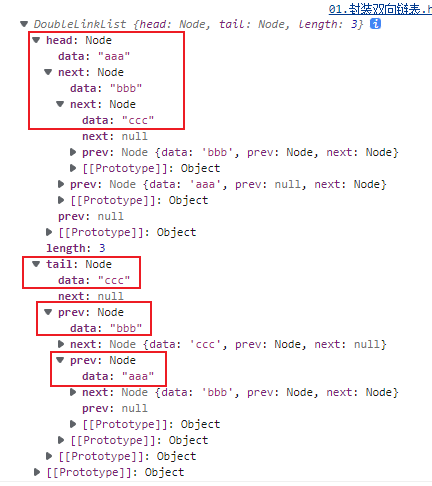
2.insert(position, data)
插入一个新节点有多种情况:
-
插入的位置为0
-
分两种情况,一是链表是空,只需要把 head 和 tail 都指向这个新节点
-
二是链表不为空,把head.prev指向newNode,再将newNode设置为head,当前head.next指向记录的老head
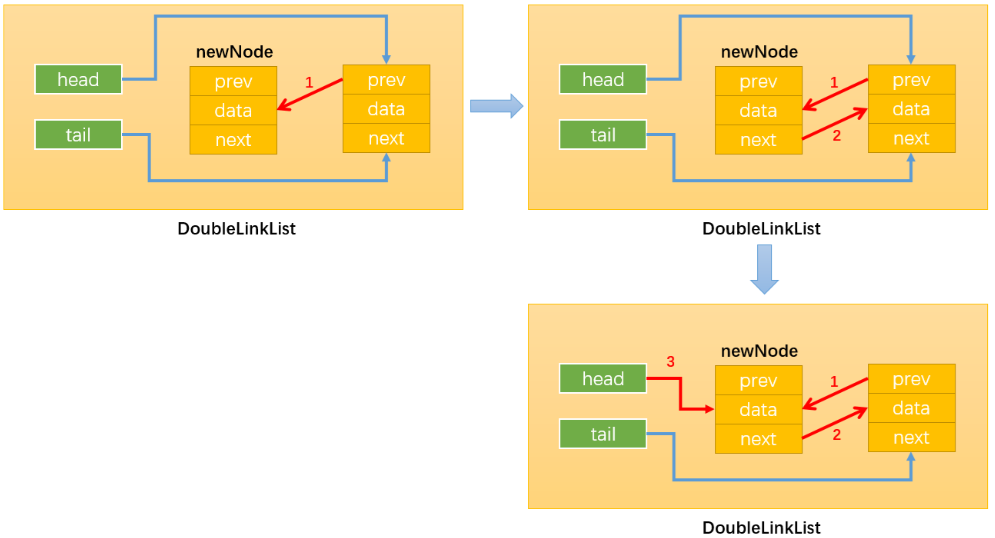
-
-
插入的位置是最后一个(position === length)
-
新节点的prev指向tail,tail.next指向新节点,再把tail重新指向新节点
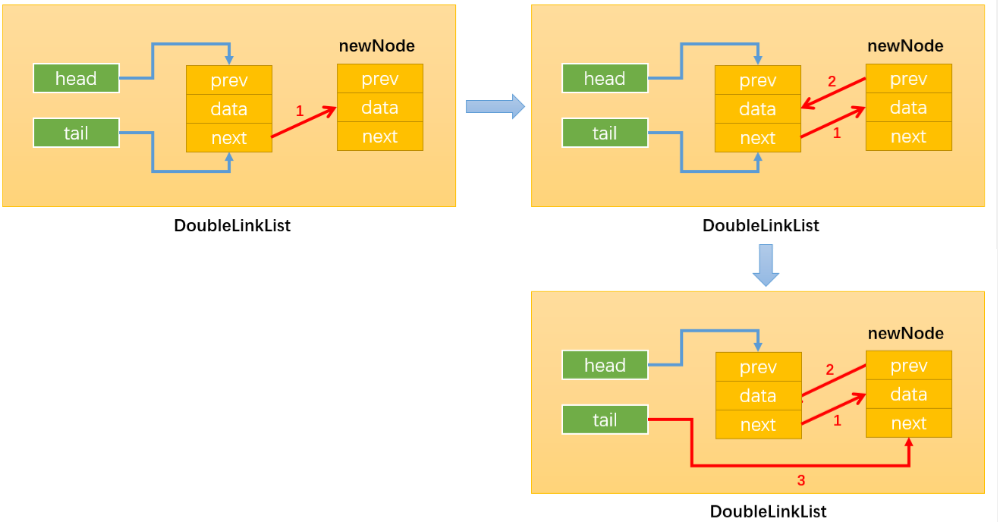
-
-
插入的位置大于0 且 小于 length
- 循环找到要插入的位置
- current.prev.next = newNode,将newNode设置为当前节点的位置
- newNode.prev = current.prev , 新节点的prev等于当前节点的prev
- current.prev = newNode,newNode.next = current,这是互相连接
- 循环找到要插入的位置
代码实现
// 指定位置插入一个节点
insert(position, data) {
// 1.越界判断
if (position < 0 || position > this.length) return false
// 2.根据data创建新节点
const newNode = new Node(data)
// 3.找到位置并插入
let current = this.head
let index = 0
let prevCurrent = null // 用来记录当前循环的节点的prev
// 3.1如果插入的时候链表是一个空链表
if (this.length === 0) {
this.head = newNode
this.tail = newNode
// 3.2如果插入的位置是0
} else if (position === 0) {
// 将当前第一个节点的prev指向新节点
current.prev = newNode
// 将新节点设置成第一个节点
this.head = newNode
// 新节点的next指向记录下来的current
this.head.next = current
// 3.3如果插入的位置最后一个(链表的长度)
} else if (position === this.length) {
newNode.prev = this.tail
this.tail.next = newNode
this.tail = newNode
// 3.4 插入的位置不是头也不是尾
} else {
while (current) {
if (index === position) {
current.prev.next = newNode
newNode.prev = current.prev
current.prev = newNode
newNode.next = current
break
}
index += 1
current = current.next
}
}
// 4.长度 +1
this.length += 1
return newNode
}
代码测试:
const dbList = new DoubleLinkList()
dbList.insert(0, 'aaa')
dbList.insert(0, 'root')
dbList.insert(2, 'bbb')
dbList.insert(1, 'root_son')
console.log(dbList);
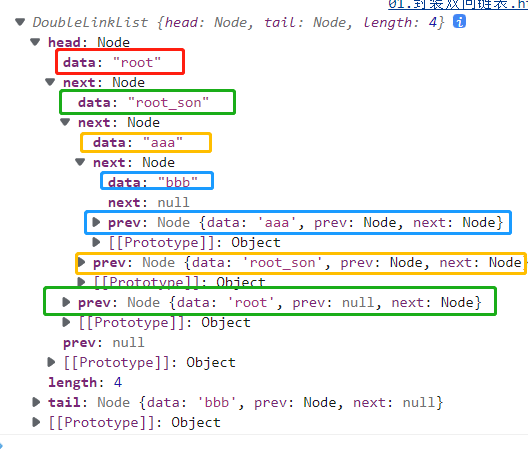
3.get(data)
代码实现
// 获取对应位置的元素
get(position) {
if (position < 0 || position > this.length) return null
let current = this.head
let index = 0
while (current) {
if (index === position) {
return current
}
index += 1
current = current.next
}
return null
}
如果考虑到性能,当节点过多,从head开始循环貌似不是最优的办法,如果节点很多,我们要找的节点又靠后呢?那将浪费很多性能,解决办法就是判断position的位置距离head和tail哪个近,就从那边循环
- position < this.length / 2,从head开始遍历
- position > this.length / 2,从tail开始遍历
优化后的代码:
// 获取对应位置的元素
get(position) {
if (position < 0 || position > this.length) return null
if (position < this.length / 2) {
let index = 0
let current = this.head
while (current) {
if (index === position) {
return current
}
index += 1
current = current.next
}
}else {
let current = this.tail
let index = this.length - 1
while (current) {
if (index === position) {
return current
}
index -= 1
current = current.prev
}
}
return null
}
测试代码
const dbList = new DoubleLinkList()
dbList.insert(0, 'aaa')
dbList.insert(0, 'root')
dbList.insert(2, 'bbb')
dbList.insert(1, 'root_son')
console.log(dbList);
console.log(dbList.get(3));
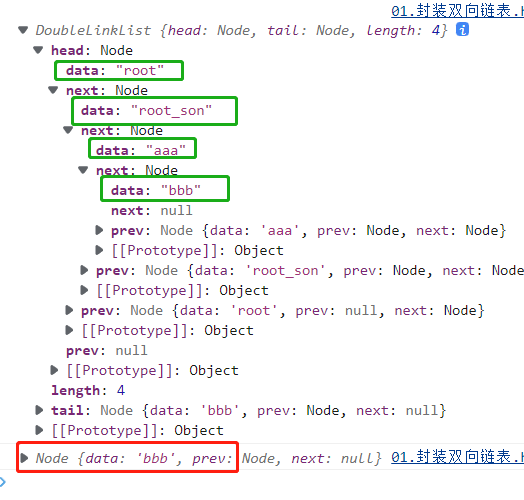
4.indexOf(data)
// 返回元素在链表中的索引
indexOf(data) {
let index = 0
let current = this.head
while (current) {
if (current.data === data) {
return index
}
current = current.next
index += 1
}
return -1
}
5.update(position, data)
实现代码
// 修改某个位置的元素
update(position, data) {
// 越界判断
if (position < 0 || position > this.length - 1) return false
// 判断position位置距离head和tail哪个近
if (position < this.length / 2) {
let index = 0
let current = this.head
while (current) {
if (index === position) {
current.data = data
return true
}
index += 1
current = current.next
}
} else {
let index = this.length - 1
let current = this.tail
while (current) {
if (index === position) {
current.data = data
return true
}
index -= 1
current = current.prev
}
}
}
测试代码
const dbList = new DoubleLinkList()
dbList.insert(0, 'root')
dbList.insert(1, 'root_son')
dbList.insert(2, 'aaa')
dbList.insert(3, 'bbb')
console.log(dbList.update(0, 'root-update'));
console.log(dbList.update(3, 'bbb-update'));
console.log(dbList);

6.removeAt(position)
删除一个节点有四种情况:
- 只有一个节点的时候,需要把head、tail指向null
- 删除第一个节点,head指向this.head.next,再把新head的prev指向null
- 删除最后一个节点,tail指向this.tail.prev,再把新tail的next指向null
- 删除中间的节点,current.prev.next指向current.next,current.next.prev = current.prev。互相指向,跳过current
实现代码
// 从链表的特定位置移除一项
removeAt(position) {
// 越界判断
if (position < 0 || position > this.length - 1) return false
// 四种情况:1.length===1。 2.移除的是第一个,3.移除的是最后一个,4.非第一个和最后一个
// 如果length===1
if (this.length === 1) {
this.head = null
this.tail = null
//移除的是第一个
} else if (position === 0) {
this.head = this.head.next
this.head.prev = null
// 移除的是最后一个
} else if (position === this.length - 1) {
this.tail = this.tail.prev
this.tail.next = null
} else {
// 移除的是中间的
let index = 0
let current = this.head
while (current) {
if(index === position) {
current.next.prev = current.prev
current.prev.next = current.next
}
index += 1
current = current.next
}
}
// 长度改变 -1
this.length -= 1
return true
}
测试代码
const dbList = new DoubleLinkList()
dbList.insert(0, 'AAA')
dbList.insert(1, 'BBB')
dbList.insert(2, 'CCC')
dbList.insert(3, 'DDD')
dbList.removeAt(1)
console.log(dbList);
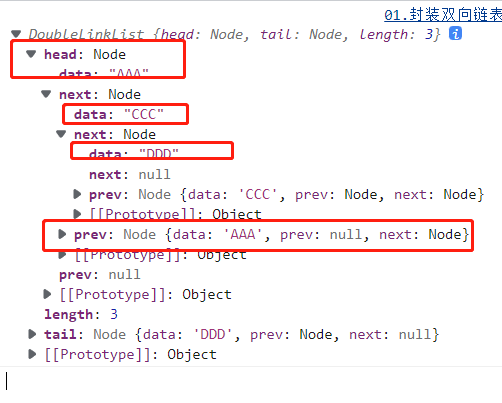
7.isEmpty()
// 链表中包不包含任何元素
isEmpty() {
return !!this.length
}
8.size()
// 返回链表包含的元素个数
size() {
return this.length
}
9.toString()
// 输出链表中字符串的值,参数: 1:正向,-1:反向
toString(data) {
if(data === 1) return this.forwardString()
if(data === -1) return this.backwordString()
}
10.forwardString()
// 返回正向遍历节点字符串形式
forwardString() {
let res = ''
let current = this.head
while (current) {
res += current.data + ' '
current = current.next
}
return res
}
11.backwordString()
// 返回反向遍历的节点的字符串形式
backwordString() {
let res = ''
let current = this.tail
while (current) {
res += current.data + ' '
current = current.prev
}
return res
}
整体代码
// 节点类
class Node {
constructor(data) {
this.data = data
this.prev = null
this.next = null
}
}
// 封装双向链表类
class DoubleLinkList {
constructor() {
// 属性
this.head = null
this.tail = null
this.length = 0
}
// 尾部添加一个节点
append(data) {
// 1.创建节点
const newNode = new Node(data)
// 2.判断添加的是否是第一个节点
if (!this.length) {
// 是第一个节点
this.head = newNode
this.tail = newNode
} else {
// 先将新节点的prev指向tail(最后一个节点)
newNode.prev = this.tail
// 再将tail(最后一个节点)的next指向新节点
this.tail.next = newNode
// 将最后一个节点设置成新节点
this.tail = newNode
}
// 3.长度+1
this.length += 1
}
// 返回正向遍历节点字符串形式
forwardString() {
let res = ''
let current = this.head
while (current) {
res += current.data + ' '
current = current.next
}
return res
}
// 返回反向遍历的节点的字符串形式
backwordString() {
let res = ''
let current = this.tail
while (current) {
res += current.data + ' '
current = current.prev
}
return res
}
// 指定位置插入一个节点
insert(position, data) {
// 1.越界判断
if (position < 0 || position > this.length) return false
// 2.根据data创建新节点
const newNode = new Node(data)
// 3.找到位置并插入
let current = this.head
let index = 0
let prevCurrent = null // 用来记录当前循环的节点的prev
// 3.1如果插入的时候链表是一个空链表
if (this.length === 0) {
this.head = newNode
this.tail = newNode
// 3.2如果插入的位置是0
} else if (position === 0) {
// 将当前第一个节点的prev指向新节点
current.prev = newNode
// 将新节点设置成第一个节点
this.head = newNode
// 新节点的next指向记录下来的current
this.head.next = current
// 3.3如果插入的位置最后一个(链表的长度)
} else if (position === this.length) {
newNode.prev = this.tail
this.tail.next = newNode
this.tail = newNode
// 3.4 插入的位置不是头也不是尾
} else {
while (current) {
if (index === position) {
current.prev.next = newNode
newNode.prev = current.prev
current.prev = newNode
newNode.next = current
break
}
index += 1
current = current.next
}
}
// 4.长度 +1
this.length += 1
return newNode
}
// 获取对应位置的元素
get(position) {
if (position < 0 || position > this.length) return null
if (position < this.length / 2) {
let index = 0
let current = this.head
while (current) {
if (index === position) {
return current
}
index += 1
current = current.next
}
} else {
let current = this.tail
let index = this.length - 1
while (current) {
if (index === position) {
return current
}
index -= 1
current = current.prev
}
}
return null
}
// 返回元素在链表中的索引
indexOf(data) {
let index = 0
let current = this.head
while (current) {
if (current.data === data) {
return index
}
current = current.next
index += 1
}
return -1
}
// 修改某个位置的元素
update(position, data) {
// 越界判断
if (position < 0 || position > this.length - 1) return false
// 判断position位置距离head和tail哪个近
if (position < this.length / 2) {
let index = 0
let current = this.head
while (current) {
if (index === position) {
current.data = data
return true
}
index += 1
current = current.next
}
} else {
let index = this.length - 1
let current = this.tail
while (current) {
if (index === position) {
current.data = data
return true
}
index -= 1
current = current.prev
}
}
}
// 从链表的特定位置移除一项
removeAt(position) {
// 越界判断
if (position < 0 || position > this.length - 1) return false
// 四种情况:1.length===1。 2.移除的是第一个,3.移除的是最后一个,4.非第一个和最后一个
// 如果length===1
if (this.length === 1) {
this.head = null
this.tail = null
//移除的是第一个
} else if (position === 0) {
this.head = this.head.next
this.head.prev = null
// 移除的是最后一个
} else if (position === this.length - 1) {
this.tail = this.tail.prev
this.tail.next = null
} else {
// 移除的是中间的
let index = 0
let current = this.head
while (current) {
if(index === position) {
current.next.prev = current.prev
current.prev.next = current.next
}
index += 1
current = current.next
}
}
// 长度改变 -1
this.length -= 1
return true
}
// 链表中包不包含任何元素
isEmpty() {
return !!this.length
}
// 返回链表包含的元素个数
size() {
return this.length
}
// 输出链表中字符串的值,参数: 1:正向,-1:反向
toString(data) {
if(data === 1) return this.forwardString()
if(data === -1) return this.backwordString()
}
}